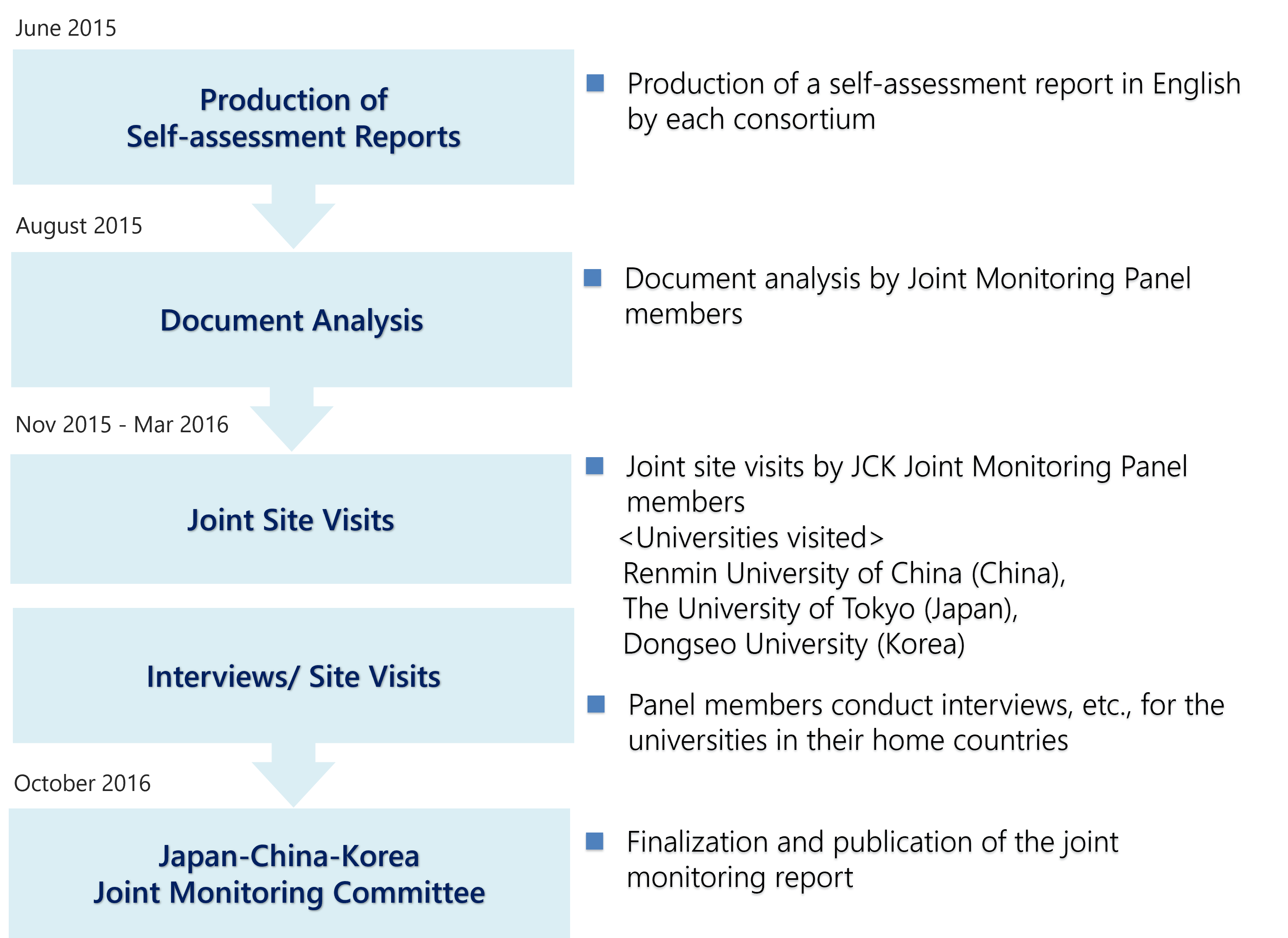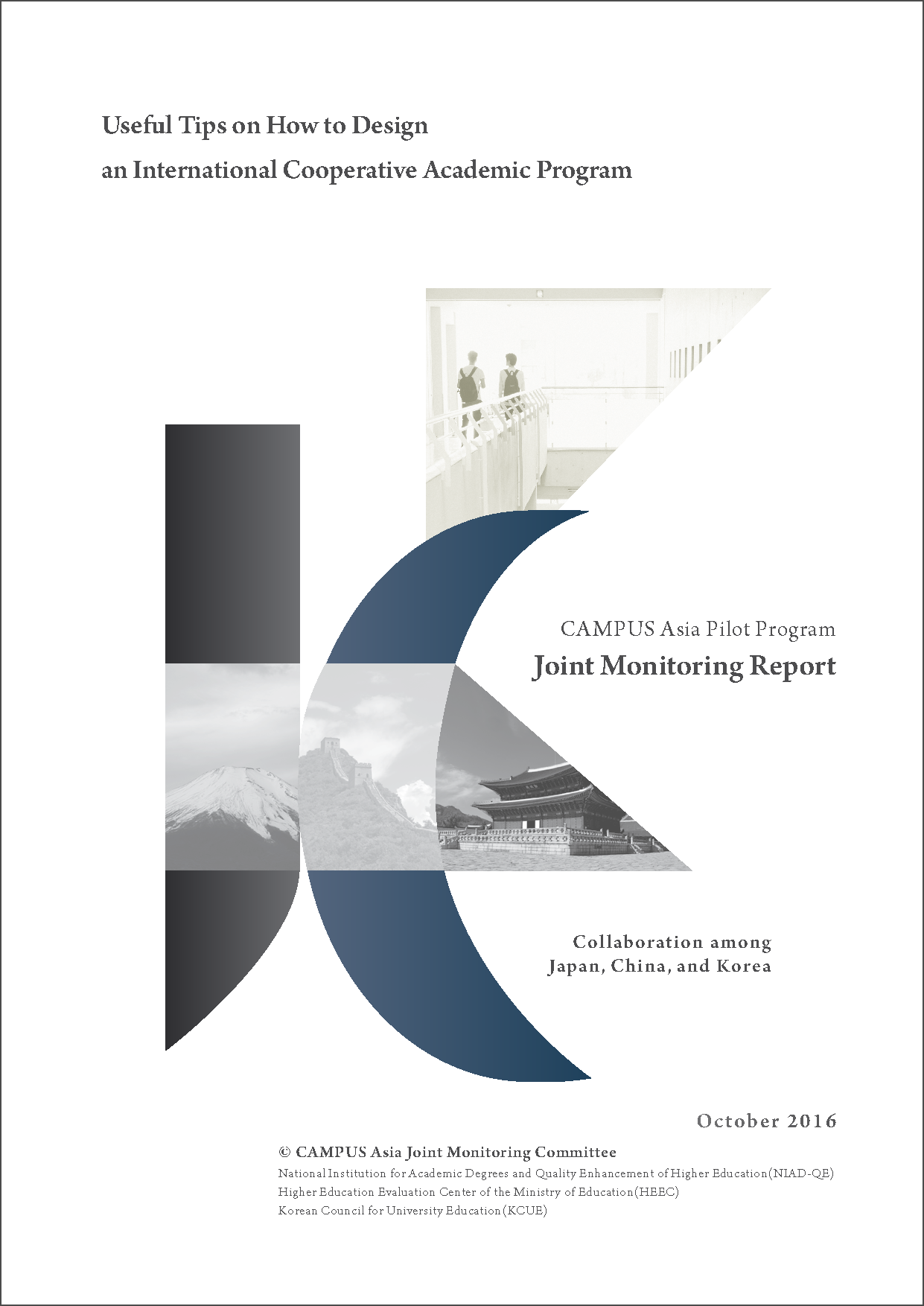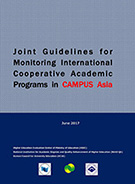2nd Monitoring
JCK 2nd Monitoring
The second Monitoring of the pilot 'CAMPUS Asia' programs (ten programs) was implemented jointly from 2015‒2016 by NIAD-UE, HEEC, and KCUE. For the implementation of the second monitoring, the three agencies developed a common framework, after a comparative analysis of the criteria, methods, and results of the first monitoring in each of the countries, in 2013-2014.
- Implementation Structure and Procedure
- Joint Monitoring Criteria
- Joint Monitoring Report
- Joint Guidelines
Implementation Structure and Procedure
For the second monitoring, the 'CAMPUS Asia' Joint Monitoring Committee and Panel were established, consisting of academic experts with knowledge of the internationalization of higher education and international collaborative programs, as well as representatives of the quality assurance agencies from Japan, China, and Korea. The Joint Monitoring Committee made relevant decisions on agendas for monitoring and finalized reports. The Joint Monitoring Panel conducted document analysis of the self-assessment reports submitted by university consortiums and site visits, as well as produced monitoring reports.
The process for implementing joint monitoring in Japan, China, and Korea are shown in the chart given below.
First, the ten consortiums of Japanese, Chinese, and Korean universities were requested to produce self-assessment reports. With adequate coordination between the participating universities, they were required to submit one report per consortium, in English, by referring to the joint monitoring criteria. Members of the Joint Monitoring Panel conducted a document analysis based on the reports produced by each consortium.
Second, following the document analysis, members of the Joint Monitoring Panel jointly visited each country, to conduct physical interviews for the three selected consortiums. Each site visit was organized using opportunities in program events, and other occasions when the member universities of the consortiums gathered. For the other seven consortiums, panel members from each country visited or interviewed the universities in their respective countries. The results of these investigations were shared among panel members from the three countries.
Subsequently, the good practices and challenges identified in each consortium's program, during the monitoring, were collected and summarized in a report. Finally, a joint monitoring report that included the results of the first monitoring, conducted in each country in 2013, was drafted by the collaborative work of the three quality assurance agencies. The report was finalized, with the monitoring results from the Joint Monitoring Committee.

Joint Monitoring Criteria
After a comparative analysis of each country's criteria in the first monitoring, five joint monitoring criteria were established for the second one, each with two sub-criteria, and totaling ten sub-criteria. These joint criteria were constructed from those established in each country, during the first monitoring. These criteria focused more on cooperation between participating universities, and the added value obtained from international collaborative programs.
| Criteria | Sub-criteria |
|---|---|
| 1. Objectives and Implementation | 1.1. Achievement of Objectives 1.2. Organization and Administration |
| 2. Collaborative Development of Academic Program | 2.1. Curriculum Integration 2.2. Academic Staff and Teaching |
| 3. Student Support | 3.1. Students Admission 3.2. Support for Learning and Living |
| 4. Added-value of the Collaborative Program (Outcomes) | 4.1. Student Satisfaction 4.2. Credit Transfer and Degree Awarding |
| 5. Internal Quality Assurance | 5.1. Self-assessment 5.2. Continuous Quality Improvement |
Joint Monitoring Report

CAMPUS Asia Pilot Program Joint Monitoring Report
(CAMPUS Asia Joint Monitoring Committee, October 2016)
This report brought together good practices and challenges in international collaborative academic programs, identified during the monitoring of each consortium by Japanese, Chinese, and Korean panel members. Instances of good practices, under each criterion monitored, were described in detail, most notably quality assurance initiatives within 'CAMPUS Asia' programs.
Joint Guidelines

Joint Guidelines for Monitoring International Cooperative Academic Programs in CAMPUS Asia
(National Institution for Academic Degrees and Quality Enhancement of Higher Education, Higher Education Evaluation Center of the Ministry of Education, and Korean Council for University Education, June 2017)
These guidelines stipulated the quality assurance criteria and methods for international collaborative academic programs, based on experiences during the trilateral second monitoring. They were produced with the hope that they would serve as a helpful model, not only for the Japanese, Chinese, and Korean quality assurance agencies conducting this monitoring, but also for other quality assurance agencies when conducting monitoring or evaluation of international collaborative academic programs. This is especially predicted to be useful when working with partner agencies in other countries, and for higher education institutions, when conducting an internal quality assurance of international education.

